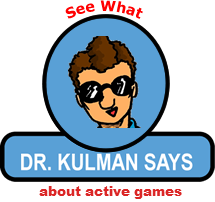Pikmin Bloom
LQ: 8.85
Recommended Age: 9+
Skills Used: Flexibility, Self-Awareness, Mathematics
Recommended LWK Games: Wii Sports Resort: Swordplay, Kinect Adventures: Reflex Ridge, Kinect Adventures: River Rush, Sports Champions: Gladiator Duel, Sports Champions: Disc Golf, Sesame Street Once Upon a Monster.
Popular M-Rated Games: No More Heroes: Heroes’ Paradise, Diabolical Pitch
Common Thinking Skills Used: Self-Control, Self-Awareness
Before the 2006 release of Nintendo Wii, active gaming hadn’t really caught on. Thanks to the Wii’s runaway success, however, active games are an increasingly popular and still expanding genre of video games. The genre’s first hit was undoubtedly Wii Sports, the pack-in compilation of 5 motion-controlled sports games (Tennis, Bowling, Baseball, Boxing and Golf) that shipped with every Wii system. Since, other companies have brought their own motion-controlled capabilities to the table, with Sony offering the PlayStation Move on PS3, and Microsoft introducing the controller-free Kinect to Xbox 360. The range of active games now available is vast, from sports games that strive to replicate real-life actions, to sword-swinging fantasy epics like The Legend of Zelda: Skyward Sword and “exergaming” titles like Wii Fit and EA Sports Active. Many active games also feature some form of multiplayer competition, which can make for some great family gaming. Activities like this not only encourage physical activity, but bring together the whole family to take part in a positive, social experience.
Managing our actions, feelings and behaviors.
 While some active games only require simple gestures to be implemented to activate in-game commands, many motion-controlled games can mimic movement with excellent accuracy. Some of these more advanced active games can track movements 1-to-1, meaning actions done outside the game are represented on-screen exactly as they are issued by players. This accuracy makes it possible to include gameplay mechanics that respond to subtle changes in movement. From adding curve to a baseball pitch, angling a Frisbee toss or adding spin to a bowling ball, players must carefully control their movements in order to execute the desired action, with even small hiccups in their execution being reflected in-game. Steady, fluid movements are generally rewarded, while hasty or sloppy actions are punished with bad scores. Even in simpler motion-controlled games, such as Kinect Sports Boxing, a steady mindful approach will outperform a hectic, uncoordinated flurry of punches.
While some active games only require simple gestures to be implemented to activate in-game commands, many motion-controlled games can mimic movement with excellent accuracy. Some of these more advanced active games can track movements 1-to-1, meaning actions done outside the game are represented on-screen exactly as they are issued by players. This accuracy makes it possible to include gameplay mechanics that respond to subtle changes in movement. From adding curve to a baseball pitch, angling a Frisbee toss or adding spin to a bowling ball, players must carefully control their movements in order to execute the desired action, with even small hiccups in their execution being reflected in-game. Steady, fluid movements are generally rewarded, while hasty or sloppy actions are punished with bad scores. Even in simpler motion-controlled games, such as Kinect Sports Boxing, a steady mindful approach will outperform a hectic, uncoordinated flurry of punches.
Understanding our own actions, thoughts and feelings.
 Multiplayer is a common feature found in many active games, especially sports or mini-game compilations. Titles like Wii Sports: Resort, Kinect Sports: Season Two and Sports Champions all offer a variety of ways for players to compete and interact, from team-based games to competitive one-on-one matches. Multiplayer activities serve as a great way to engage insular kids in social activities, and can serve as a stepping stone to becoming comfortable in larger, less familiar social environments. Playing competitive games with close friends and family can be the first step towards engaging in other, real-world activities based around competition, while also serving a simple, fun way to bring family together around a common activity.
Multiplayer is a common feature found in many active games, especially sports or mini-game compilations. Titles like Wii Sports: Resort, Kinect Sports: Season Two and Sports Champions all offer a variety of ways for players to compete and interact, from team-based games to competitive one-on-one matches. Multiplayer activities serve as a great way to engage insular kids in social activities, and can serve as a stepping stone to becoming comfortable in larger, less familiar social environments. Playing competitive games with close friends and family can be the first step towards engaging in other, real-world activities based around competition, while also serving a simple, fun way to bring family together around a common activity.
 With the advent of the Wii U, PlayStation Move, Microsoft’s Kinect, and the old standby, the Nintendo Wii, video games aren’t just for sitting on the couch and using your thumbs. These new control schemes allow gaming to be truly active, with games designed for all types of movement, some of which provide a pretty decent physical workout. While I would hesitate to say that playing such games is as good as exercising outdoors or in your local gym, there still appears to be a tangible benefit to be gleaned for active gaming It depends on what you’re doing. In fact, if your idea of a workout is going for a slow-paced, 15-minute walk, there’s a good chance that you can get a far better workout, burn many more calories, and get the psychological benefits of exercise from a vigorous, active game experience.
With the advent of the Wii U, PlayStation Move, Microsoft’s Kinect, and the old standby, the Nintendo Wii, video games aren’t just for sitting on the couch and using your thumbs. These new control schemes allow gaming to be truly active, with games designed for all types of movement, some of which provide a pretty decent physical workout. While I would hesitate to say that playing such games is as good as exercising outdoors or in your local gym, there still appears to be a tangible benefit to be gleaned for active gaming It depends on what you’re doing. In fact, if your idea of a workout is going for a slow-paced, 15-minute walk, there’s a good chance that you can get a far better workout, burn many more calories, and get the psychological benefits of exercise from a vigorous, active game experience.
Child psychiatrist Paul Ballas has gone so far as to call for an exercise rating system to gauge a video game’s workout capacity, which would give consumers an idea of the level of intensity involved with playing the game. There is substantial evidence that active video games generally burn far more calories than sedentary activities, and an article from the Journal of Pediatrics indicates that energy expenditures while involved in active gaming increase threefold when compared to watching television. Much of this obviously depends on exertion and the type of game being played, but there nevertheless remains a clear potential for encouraging less active children to turn their game time into a healthy, active experience.
Active games aren’t just good for your physical health, either, as the heavily social multiplayer features many of these games provide can also serve as a great way to bring families together. Active games tend to be ideal games for kids to play with their parents, siblings or grandparents, as they are generally very easy to learn, and such family activities are likely to result in a lot of laughs and very positive interactions. Active games have become a staple of many senior community centers, too, so don’t be surprised if Grandma and Grandpa are better at some of these games than their grandchildren!
Some pundits argue that playing video games is not as good as the real thing and therefore diverts people from real-world exercise opportunities. On the one hand, I partially agree. As an avid bicyclist, I definitely prefer to be outdoors, breathing fresh air and taking on the challenges of a tough terrain or keeping up with a biking partner. However, during the winter or after a late day in the office, if I want to stay fit, I readily choose to ride an indoor exercise bike while listening to my iPod. Being able to sustain my fitness level during these times not only allows me to more fully appreciate opportunities outdoors, but makes exercise possible when it would otherwise not be an option.
As an aging adult (don’t let the dashing drawing fool you), I’m really excited about using active video games as a part of my fitness routine. As psychologists, we are well aware of the power of vigorous physical exercise to reduce stress, improve mood, and enhance one’s capacity to sustain attention. Tools that help us to enjoy exercise, do it more readily, and enhance our commitment and time towards exercising are important for maintaining positive psychological health.
All membership plans come with full access to our entire suite of tools learning guides, and resources. Here are a few of the ones we think you’ll like the most: